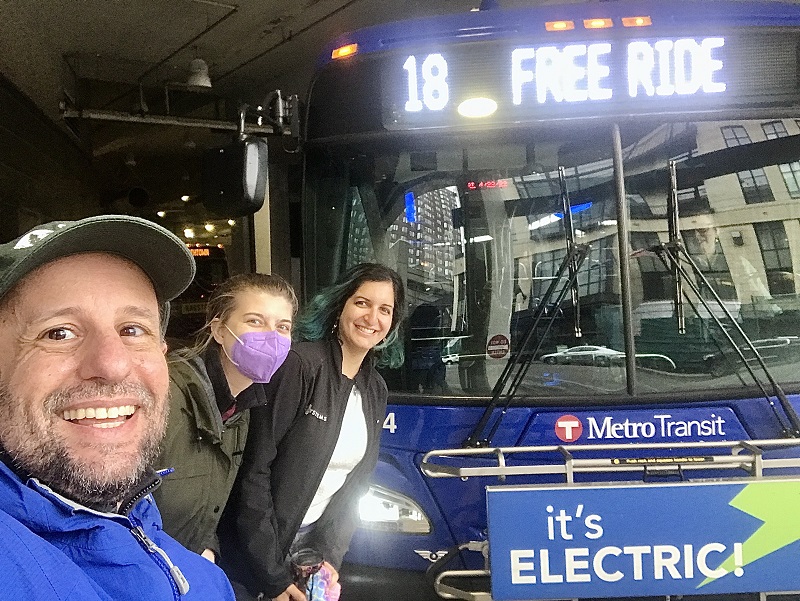
The author takes a ride on a clean, zero emission electric Metro Transit Bus with MK Anderson and
Anjali Bains, Coalition for Clean Transportation allies from Fresh Energy. Selfie by Joshua Houdek
by Joshua Houdek
You likely know that transportation is the number one contributor to climate change pollution in Minnesota, as well as nationwide.Our Land Use and Transportation Team is working hard to tackle this problem and provide equitable solutions by reducing Vehicle Miles Traveled (VMT) and increasing electrification.
We can reduce VMT by making it easier, safer, more convenient and more fun to walk, bike, and take public transit. Zero emission electric buses, like the one pictured above, do both. Transit reduces the need to drive, especially in urban areas of our state, and when we replace dirty diesel with clean electric, buses are a win-win!
We need more (many more) electric vehicles to make a difference. In 2021, Minnesota became the first Clean Car state in the midwest. It was a huge victory for the Sierra Club, our allies, and the nation and it sent a strong signal to automakers worldwide. Passing Clean Cars creates stricter standards that will require new cars and light trucks (pickups & SUVs) sold in Minnesota to emit less climate-disrupting pollution. It will also increase the availability and sales of zero-emission (i.e. electric) vehicles.
But the new standards don’t address electrifying medium and heavy-duty (MHD) vehicles like delivery vans, larger trucks, and buses, the biggest source of health-harming diesel emissions in Minnesota.
We collaborated with the Coalition for Clean Transportation on a new report from Fresh Energy that forecasts the benefits of adopting policies that support the rapid electrification of MHD vehicles. By advancing policies like Clean Cars for trucks and buses, Minnesota could reap cumulative societal benefits of up to $18.5 billion.
Taking these steps will also help us get back on track to meet our state climate goals, while boosting community health, particularly for communities living near high-traffic roadways, a large portion of whom are Black, Indigenous, and People of Color (BIPOC), and/or under-resourced.
While MHD vehicles only make up 9% of on-road vehicles in Minnesota, they account for 31% of greenhouse gas (GHG) emissions, 62% of nitrogen oxide (NOx) emissions, and 55% of fine particulate matter. We have so much to gain by tackling toxic trucks and buses, including:
-
Reducing CO2 pollution by 35 to 88 million metric tons. That’s equivalent to removing more than seven million passenger vehicles from the road for one year.
-
Avoiding more than 100 premature deaths and nearly 100 hospital visits annually.
-
Saving more than $1.3 million in health-related costs annually.
-
Saving more than $16,000 over the life of each vehicle by 2030 in fuel and maintenance.
Madi Johnson, a clean transportation organizer with MN350 explains: “Right now, cities and schools are leading on large vehicle electrification. We need to see statewide goals and policies in place.”
Policies and investment to speed up electrification of MHD vehicles make sense from a climate, health, and economic perspective. For more information on how you can get involved in jump-starting the electrification of Minnesota’s transportation sector, please contact Joshua Houdek.
Joshua Houdek is senior program manager for Land Use and Transportation. He gets around primarily by bike and bus, and when his family’s internal combustion engine vehicle kicks the bucket, he plans on going electric.